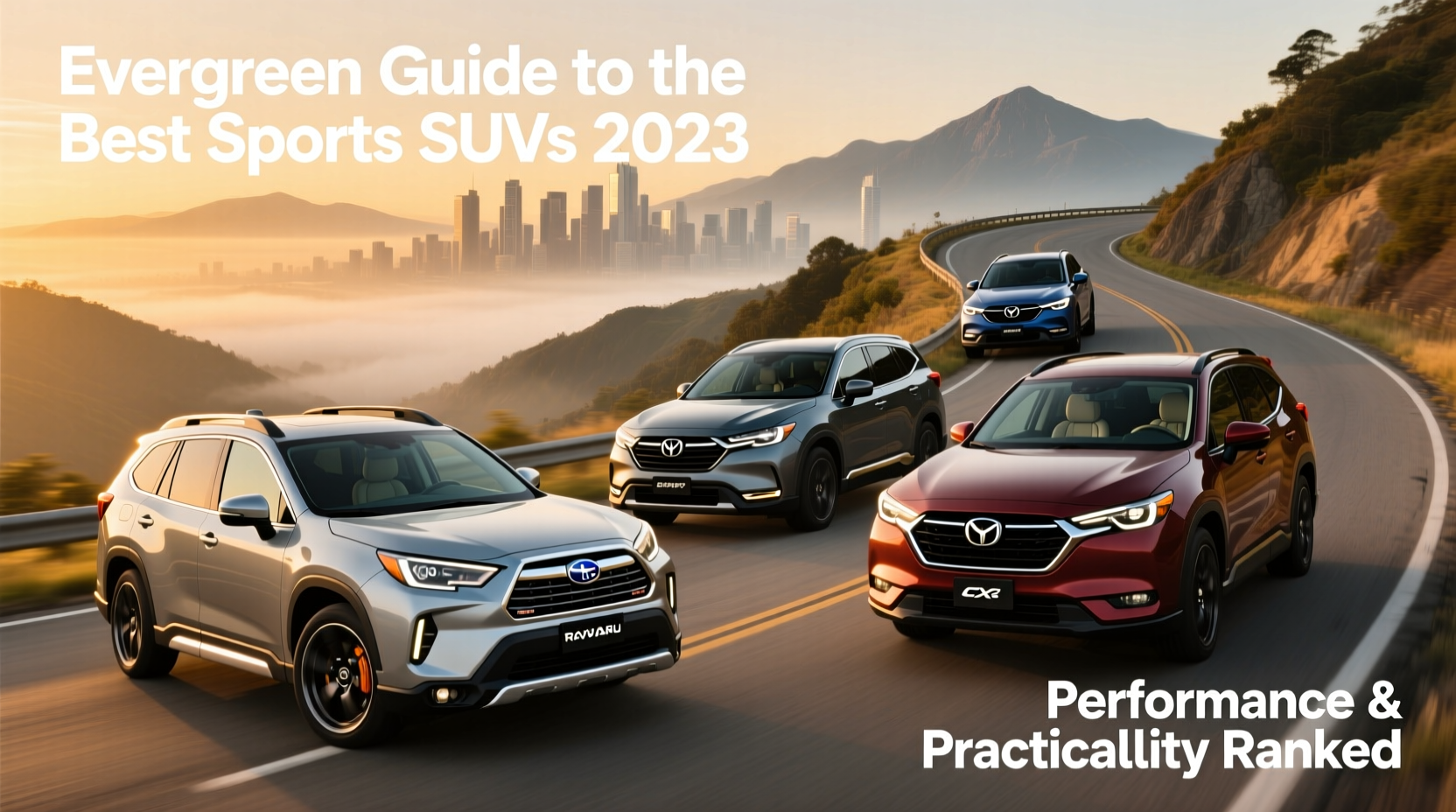In 2023, the line between high-performance vehicles and family-friendly SUVs has blurred into a compelling category: the sports SUV. These machines deliver exhilarating acceleration, precise handling, and aggressive styling—without sacrificing cargo space, passenger comfort, or daily drivability. Whether you're navigating mountain passes on a weekend escape or commuting through city traffic with car seats installed, today’s top sports SUVs offer a rare blend of excitement and utility. This guide cuts through the marketing noise to spotlight the models that truly excel across performance, technology, and real-world usability.
What Defines a True Sports SUV?

A sports SUV isn’t just an SUV with a turbocharged engine bolted on. It’s a vehicle engineered from the ground up—or significantly refined—to deliver dynamic driving dynamics while retaining the versatility expected of a modern crossover. Key characteristics include:
- Performance-tuned suspension: Adaptive dampers and lower ride heights enhance cornering stability.
- High-output powertrains: Twin-turbo V6s, V8s, or high-performance electric motors delivering 400+ horsepower.
- All-wheel drive systems: Advanced torque vectoring for improved traction and agility.
- Sport-oriented interiors: Heated, bolstered sport seats, carbon fiber trim, and performance-focused infotainment.
- Braking and cooling upgrades: Larger rotors, multi-piston calipers, and enhanced thermal management.
“Today’s best sports SUVs don’t ask you to compromise. You get track-capable dynamics and enough room for soccer gear, groceries, and road trip luggage.” — Marcus Lin, Automotive Editor at DriveWeek
Top 5 Sports SUVs of 2023: Performance Meets Practicality
The following models represent the pinnacle of engineering in the sports SUV segment. Each offers a distinctive character, but all succeed in harmonizing speed, control, and livability.
1. Porsche Cayenne GTS
The Cayenne GTS remains a benchmark. Its naturally aspirated-feeling 4.0L twin-turbo V8 produces 473 horsepower and routes power through a snappy eight-speed PDK transmission. With standard adaptive air suspension and rear-axle steering, it corners like a sedan yet seats five comfortably. The interior blends minimalist elegance with tactile controls, and cargo space (27.5 cubic feet behind the second row) is generous for its class.
2. BMW X5 M Competition
With 617 horsepower from a 4.4L twin-turbo V8, the X5 M Competition is a full-size brute that defies physics. Zero to 60 mph arrives in just 3.7 seconds. Despite its ferocity, it offers three rows of seating, advanced driver aids, and a luxurious cabin with available Merino leather and massaging front seats. The trade-off? Fuel economy dips below 15 mpg in mixed driving.
3. Audi RS Q8
The RS Q8 combines stealthy looks with explosive performance—591 hp, quattro AWD, and a 3.5-second 0–60 time. Its coupe-like roofline reduces rear headroom slightly, but the cabin is opulent, featuring Valcona leather and Bang & Olufsen audio. Standard features include adaptive cruise, lane keep assist, and a panoramic sunroof. For tech-forward drivers who want drama without drawing attention, this is a standout.
4. Tesla Model X Plaid
Electric performance redefined: the Model X Plaid hits 60 mph in 2.5 seconds, thanks to tri-motor all-wheel drive. Beyond speed, it delivers 250 miles of range (EPA), falcon-wing doors for easy rear access, and over-the-air updates. While some criticize its ride firmness and interface quirks, the lack of engine noise and instant torque make it uniquely thrilling. Cargo capacity reaches 91 cubic feet with seats folded—ideal for active families.
5. Alfa Romeo Stelvio Quadrifoglio
The most driver-focused option here, the Stelvio Quadrifoglio packs a Ferrari-derived 2.9L twin-turbo V6 making 505 hp. At 3.6 seconds 0–60, it’s one of the quickest SUVs ever built. The DNA drive mode selector lets drivers toggle from efficiency to race-mode aggression. Interior space is tighter than rivals, but the emotional connection behind the wheel is unmatched. Best suited for enthusiasts who prioritize engagement over third-row flexibility.
Comparison Table: Key Metrics at a Glance
| Model | Horsepower | 0–60 mph | Fuel Economy (MPG) | Cargo Space (cu ft) | Starting Price |
|---|---|---|---|---|---|
| Porsche Cayenne GTS | 473 | 4.3 sec | 17 city / 23 hwy | 27.5 | $93,700 |
| BMW X5 M Competition | 617 | 3.7 sec | 13 city / 18 hwy | 31.7 | $110,900 |
| Audi RS Q8 | 591 | 3.5 sec | 16 city / 21 hwy | 22.9 | $117,600 |
| Tesla Model X Plaid | 1,020 (est.) | 2.5 sec | 107 MPGe | 91 | $109,490 |
| Alfa Romeo Stelvio Quadrifoglio | 505 | 3.6 sec | 16 city / 24 hwy | 18.5 | $89,895 |
Real-World Use Case: The Weekend Warrior’s Dilemma
Consider Sarah, a project manager and mother of two based in Colorado. She needs a vehicle that handles snowy commutes, fits ski gear for four, and still feels engaging on her favorite canyon roads during solo drives. After testing several models, she chose the Porsche Cayenne GTS. “It’s the only SUV where I feel connected to the road,” she says. “I can drop the kids at school, then take a detour through the Rockies and actually enjoy myself. And yes—it fits all our ski bags, helmets, and boots without folding seats.”
This scenario reflects a growing trend: professionals seeking vehicles that serve multiple roles without compromise. The Cayenne, and others like it, fulfill that dual mandate—practical when needed, passionate when desired.
Actionable Buying Checklist
Before finalizing your decision, verify these critical aspects:
- Test drive in varied conditions: Include highway cruising, city stop-and-go, and winding roads.
- Evaluate cargo accessibility: Can you easily load strollers, groceries, or sports equipment?
- Check tech integration: Does Apple CarPlay/Android Auto work seamlessly? Is voice control responsive?
- Review ownership costs: Research insurance premiums, maintenance schedules, and tire replacement frequency.
- Assess warranty coverage: Look for at least 4 years/50,000 miles bumper-to-bumper protection.
- Confirm charging infrastructure (for EVs): Ensure home charging is feasible and public networks are reliable in your area.
Frequently Asked Questions
Are sports SUVs worth the premium over standard models?
For drivers who value driving engagement and have the budget, yes. The upgrades in suspension, braking, and power delivery transform the experience. However, if you rarely drive aggressively or prioritize fuel economy, a well-equipped standard model may suffice.
Do electric sports SUVs handle as well as gasoline-powered ones?
In many cases, better. The low center of gravity from battery placement improves stability, and instant torque enables rapid acceleration. However, heavier curb weights can affect agility in tight corners. Models like the Model X Plaid and upcoming Lucid Gravity aim to close this gap with advanced chassis tuning.
Can a sports SUV be family-friendly?
Absolutely. Most offer LATCH connectors, spacious second rows, quiet cabins, and advanced safety suites. The BMW X5 and Tesla Model X even provide optional third-row seating. Just ensure headroom and legroom meet your family’s needs before committing.
Final Thoughts: Choosing Your Ideal Balance
The best sports SUV of 2023 isn’t defined by horsepower alone—it’s the one that aligns with your lifestyle. Enthusiasts will gravitate toward the Alfa Romeo Stelvio Quadrifoglio’s raw emotion. Tech adopters may prefer the silent fury of the Tesla Model X Plaid. Those balancing luxury and performance might find perfection in the Porsche Cayenne GTS. And families needing space with a side of speed will appreciate the BMW X5 M’s versatility.
No matter your preference, today’s market offers unprecedented choice. These vehicles prove that performance no longer means sacrificing practicality. They’re not just fast—they’re functional, intelligent, and built for real life.









 浙公网安备
33010002000092号
浙公网安备
33010002000092号 浙B2-20120091-4
浙B2-20120091-4
Comments
No comments yet. Why don't you start the discussion?